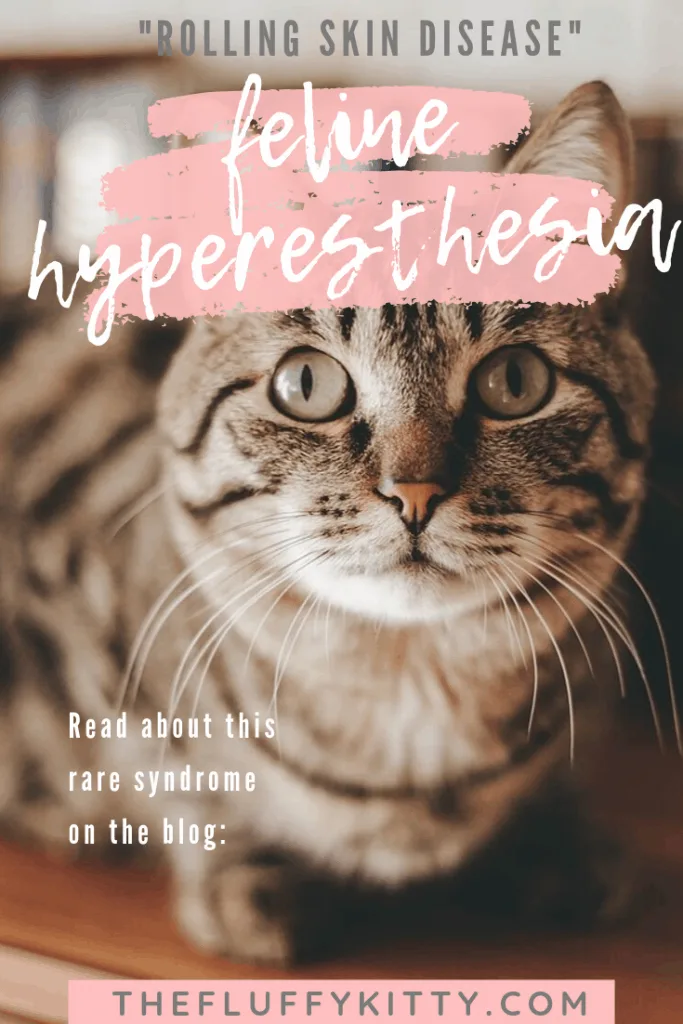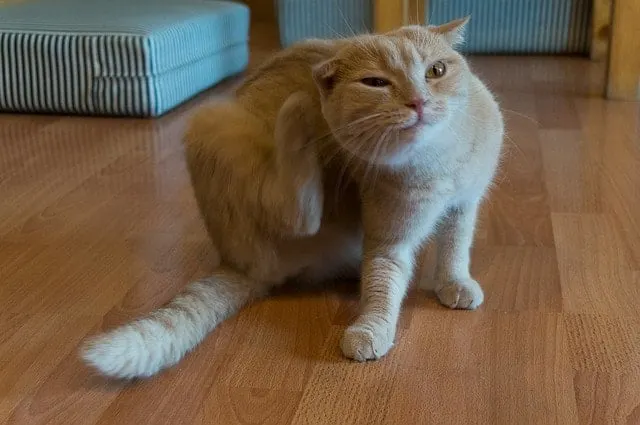It’s no doubt that our cats can display some odd behaviors. Some cats twitch when they’re touched, run from what appears to be nothing, and bite at an itch that just doesn’t seem to disappear. Each cat comes with its own personalized list of quirks.
But what if these strange antics aren’t actually quirks, but a mysterious medical condition?
Feline hyperesthesia syndrome is a rare, but very real condition that should be understood among cat owners.
Pin & Save For Later!

What Is Feline Hyperesthesia?
Feline Hyperesthesia (FHS) is also referred to as twitching-skin syndrome, rolling-skin disease, or atypical neurodermatitis.
FHS is a condition that affects the skin and neuromuscular systems, resulting in twitching, agitation, and even self-mutilation.
In this strange disorder, the muscles along the back and pelvis are affected. Nerves in this area begin to fire, causing an odd and uncomfortable sensation along the cat’s back.
While the nerves are firing, the skin will often twitch and roll, leading to its reference as rolling-skin disease. These sensations can last for seconds, and even minutes, sending a cat into a bizarre fit.
These fits can present in such an extreme way, that some researchers refer to this condition as a type of seizure disorder.
While it is not yet fully understood, there’s no doubt that this syndrome can cause distress and confusion for our feline friends.
Symptoms of Twitching-Skin Syndrome
This twitching condition can present in many ways, which can make it a bit challenging to diagnose.
Each affected cat may experience their own individual symptoms, but the most common signs include:
- Rippling or twitching of skin on the back
- Tail flicking and twitching
- Sudden jumping or running
- Biting or licking the back and tail
- Compulsive grooming
- Dilated pupils
- Increased salivation or drooling
- Vocalization such as howling, crying, or meowing
- Appearing frightened
- Bothered by touch, or sensitivity to touch
- Sudden outburst of aggression or mood changes
- Appearing to be painful
The most common complaint with Feline Hyperesthesia is a sudden reaction from an otherwise calm cat.
These cats will often be in a relaxed state and will suddenly jump up, and begin biting at their back for no apparent reason.
They often have dilated pupils during these episodes, and appear to be in a frantic or frightened state.
These episodes can be so severe that some cats will even self-mutilate, pulling the hair from their back in this agitated state. This can lead to bald spots, skin lesions, and even secondary infection from chronic irritation.
These episodes can occur as infrequently as once a month, to as many as multiple times a day.
The differences in each cat’s symptoms are what makes this condition so strange, and even difficult to diagnose.
(Below is a video of a cat with Feline Hyperesthesia that is experiencing an episode)
Possible Causes of FHS
No one knows exactly what causes hyperesthesia in cats, but there is a list of possibilities. Some of these include:
Seizure disorders: Since some cats have such severe episodes, some refer to this condition as an epileptic disorder. Some cats have even been known to have actual seizures after an FHS fit. Because of this, it’s very possible that this condition stems from improper electrical activity in the brain.
Dietary deficiency: It’s possible that feline hyperesthesia is brought on in cats with dry and itchy skin. Cats with extremely dry and itchy skin are often experiencing an omega 3 fatty acid deficiency. This can happen with cats on dry food or ones who are receiving an improperly balanced homemade diet.
Obsessive-compulsive disorder (OCD): Some researchers believe hyperesthesia is nothing more than an OCD behavior, with the obsession being compulsive grooming.
Breed related: Some believe that certain cat breeds are predisposed to this condition as a result of stress. Some oriental breeds of cats are known to experience more severe stress than other breeds, so this hyperesthesia could be a type of mania that results from their stress.
Neuromuscular disorders: Feline hyperesthesia is also thought to be related to some kind of neuromuscular disorder, because of the relief that FHS cats experience when visiting feline chiropractors.
Diagnosis of Rolling-Skin Disease
Diagnosis of Feline Hyperesthesia is mostly about ruling out other conditions.
There are a few different conditions that can mimic these symptoms in a cat, so it’s important to make sure that nothing else is missed.
Only when your veterinarian can rule out a list of other possibilities, is when they can definitely diagnose FHS in a cat.
Some conditions that can mimic FHS are:
- Skin irritation resulting from fleas, other skin mites, allergies, and bacterial or fungal infections
- Hyperthyroidism – as this condition can cause hair loss and odd behavior
- Underlying painful conditions of the back end (injuries, spinal conditions, anal gland pain)
- Issues in the brain (tumors, head trauma)
- Toxicity from any kind of poisoning or foreign substance
Because of these other possible factors, a veterinarian will likely perform blood work, x-rays, and skin scrapings once these symptoms are reported.

Oftentimes a cat with FHS will frantically scratch and bite at “something that’s not there.” PC: Pixabay
Is Feline Hyperesthesia Painful?
While there is no way to definitively know if FHS is painful, we can only base this off the reactions that cats have to these episodes.
Cats often react as if something is truly bothering them during an FHS fit, so it has to be somewhat uncomfortable.
Some doctors compare these episodes to the feeling of when your leg or foot falls asleep. We know that this can be an incredibly uncomfortable sensation, and even painful at times.
Treatment of Feline Hyperesthesia
The main recommendation for relieving the symptoms of FHS is stress reduction.
Like so many feline conditions, stress can be a trigger for these uncomfortable twitching episodes.
Cats thrive in a consistent environment that they can trust. This means that you should implement daily routine, have a stable home environment, and provide consistency in your daily interactions.
Sensory stimulation and exercise are also recommended in the treatment for cats with FHS. Many kinds of behavioral disorders are eased with the addition of appropriate playtime and interaction with your cat.
Providing them with enrichment in their home, playing with interactive toys, and even playtime with a friendly feline friend is helpful.
Diet is also an important factor to consider. Dietary deficiencies can be linked to many hormonal and behavioral problems in cats, so it’s important to make sure that each cat is eating a well-balanced diet.
It’s recommended to speak to your vet about your cat’s current diet, and if any nutritional resources should be added to their daily intake.
For the cats with severe twitching episodes, medication may be recommended.
Anti-seizure medications and medications that help to relieve nerve pain can be helpful in severe cases of FHS. These medications are often the last step in finding relief for cats with this bizarre twitching disorder.
Feline Hyperesthesia in a Nutshell
Overall, FHS is considered a mild condition without a severe effect on a cat’s overall health. When managed with the help of a veterinarian, cats with FHS can go on to live a normal and comfortable life.
Now that you understand this strange condition, you have all the tools needed to stop FHS in its tracks if it ever makes its way into your furry friend’s life!
Pin this Pawticle!
Help spread awareness of Feline Hyperesthesia with other loving cat owners.

